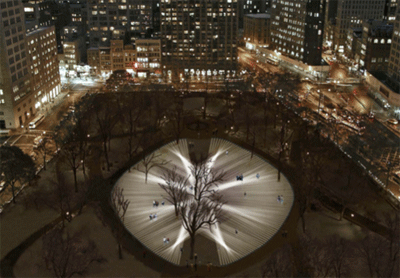
Madison Square Park Conservancy described their calendar for this year as "ambitious" in their press release and, judging from the amount of coverage we've allotted their public art program in the Rhizome blog this week, this is certainly so. Rafael Lozano-Hemmer, the Montreal-based artist slated to present work in the park this November, gave an informative lecture about his upcoming project Pulse Park (2008) at the Parsons The New School for Design last week. The inspiration for Pulse Park came about during his wife's pregnancy, when the artist listened to the heartbeats of his twins for the first time. "We could hear how different the heartbeats were, and the pattern - the music - that was generated by the pulses was really fascinating," he reminisced. Imagine that rhythmic pattern scaled up one hundred times, and you'll have an idea of the scope of his proposal for the interactive light installation Pulse Park, which is set to transform the oval lawn of Manhattan's Madison Square Park into a complex matrix of throbbing lights in synchronization with the heartbeats of passersby. During his talk, he explained how this complex operation would function. Two hundred aircraft landing lights will surround the oval lawn, pointing toward the center; on the north and south sides of the lawn will be a computer-equipped stand with two cylindrical metal tubes. When a user grabs the tubes, a sensor picks up the heart rate as well as the amplitude and shape of the beat's waveform. The system translates those variables into a unique pulse of light, which appears in the first light to the left. When the next user records his heart rate, the first person's pulse moves one down the line along the perimeter, and so on. After a pulse has traveled all the way down the line, it is extinguished, providing "a little bit of a memento mori," Lozano-Hemmer said in an interview. While the heartbeat holds myriad poetic and romantic connotations, in post-9/11 New York, co-opting biometric technologies gives the piece a certain political significance. "I'm interested in trying to identify what makes us unique, and instead of using it for tracking individuals, converting it into something that is an array - to make it connective, social, and architectural," he explained. - Lisa Delgado
Image: Rafael Lozano-Hemmer, Proposal for Pulse Park, 2008


"Lozano-Hemmer said in an interview. While the heartbeat holds myriad poetic and romantic connotations, in post-9/11 New York, co-opting biometric technologies gives the piece a certain political significance. "I'm interested in trying to identify what makes us unique, and instead of using it for tracking individuals, converting it into something that is an array - to make it connective, social, and architectural," he explained. - Lisa Delgado "
Doesn't finding things that are unique to a person make it easier to track an individual? Isn't that the whole point.